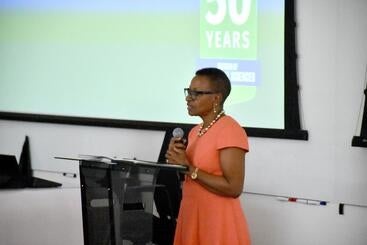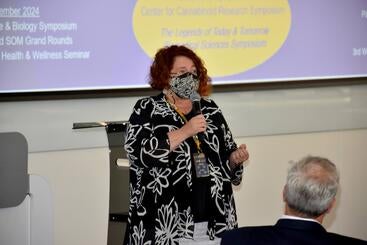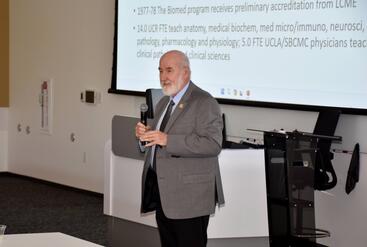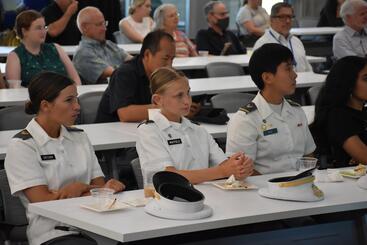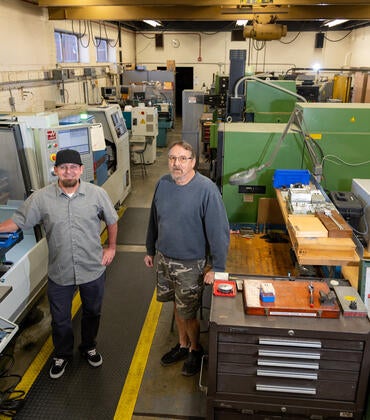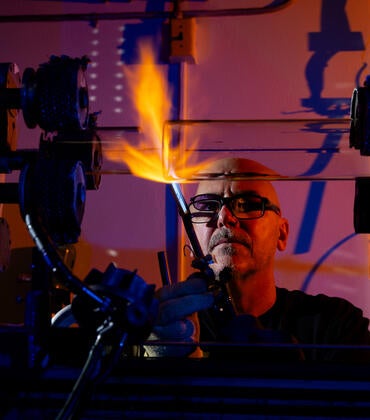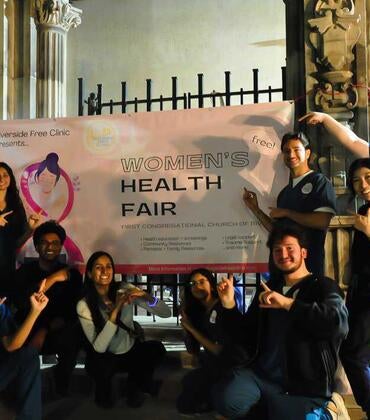The Division of Biomedical Sciences in the UCR School of Medicine kicked off its 50th anniversary celebration with an event on campus on July 15 that was attended by numerous current and former faculty members, staff, and students, as well as members of the community.
Scott Pegan, a professor of biomedical sciences, served as the master of ceremonies and welcomed the audience and introduced the speakers, starting with Dr. Deborah Deas, vice chancellor of health sciences and the Mark and Pam Rubin Dean of the School of Medicine.
“The Division of Biomedical Sciences is the foundation on which UCR’s School of Medicine was founded,” Deas said in her opening remarks. “Fifty years ago, the division was established with a vision to push the boundaries of biomedical research and to educate future generations of scientists with rigor and excellence. Today, we not only commemorate the achievements of 50 years of research, but we reflect on a remarkable journey that has brought us to this moment.”
The Division of Biomedical Sciences, launched in 1974, originated the idea of establishing a medical school on campus. The division also supported the UCR/UCLA Program in Biomedical Sciences, an accelerated Bachelor of Science/MD program, which preceded the School of Medicine. The program was created to become a magnet for the strongest students in California and be an opportunity for UCR to distinguish itself.
“As we look to the future, we are filled with optimism and determination,” Deas said. “We will continue to push the boundaries of knowledge to educate and inspire the next generation of scientists and physicians, and to serve our community with compassion, integrity, excellence, and respect.”
Monica Carson, chair of the Division of Biomedical Sciences, said the occasion was also a celebration of the next 50 years of the division.
“We are starting today to remember where we have been,” she said. “We got here through effort, we didn’t come here perfectly, we had bumps and bruises along the way. But we kept coming together, and that’s what is so inspiring about our community. We keep learning from each other. We want to spend this anniversary year remembering coming together.”
The division will host a series of events throughout the year, including lectures, seminars, and symposiums, Carson said. She invited the audience members to share their memories and experiences associated with the division.
“Whether you joined Biomed today, or anywhere along our history, whether you were with us for a day, a year, a decade, or an entire career, please share your stories and memories with us,” she said. “We want you to help us collect your stories, to understand our history, our present, and our future.”
Neal Schiller, an emeritus professor of biomedical sciences who served as interim dean of the medical school in 2015, gave a brief synopsis of the division’s important transition periods.
“In 1970, why did we think to start a new seven-year program at UCR?” he said. “The UCLA medical school wanted to grow its class of medical students. It had 135 students and wanted to grow the class to 150-160 or more. But in those days, it was laboratory-intensive for medical students, and UCLA ran out of laboratory space. They were looking for a partner who might help them take care of the first two years of medical school. UCR stepped up.”
In 1974, the first group of students joined the UCR Division of Biomedical Sciences and were admitted into the biomedical sciences major. The program almost ground to a halt in the mid-1980s when physicians at the San Bernardino County Medical Center, who trained the second-year UCR students, became unavailable due to a dispute between the medical center and UCLA.
“This jeopardized having the second year of the program at UCR,” Schiller said. “Fortunately, Harbor-UCLA Medical Center stepped forward to handle the second year. But we wanted this second year back at UCR. Eventually, the program found local physicians to train our second-year students.”
In 1997, the program was renamed the UCR/UCLA Thomas Haider Program in Biomedical Sciences after a generous gift to the program from Dr. Thomas Haider, a renowned spine surgeon, and his wife Salma.
The day’s festivities concluded with talks by Seema Tiwari-Woodruff, director of the Biomedical Sciences Graduate Program, Milton Hamblin, director of the Biomedical Sciences Master’s Program, and Pegan, vice chair of the Division of Biomedical Sciences, who discussed several undergraduate programs in the division.
Pegan introduced three cadets from the U.S. Military Academy at West Point who are doing research internships in the Biomedical Sciences program.
“With this new program that aims to build research-based bridges between the institutions, we seek to further add to our diversity and commitment to the region in terms of the veteran population,” he said.

